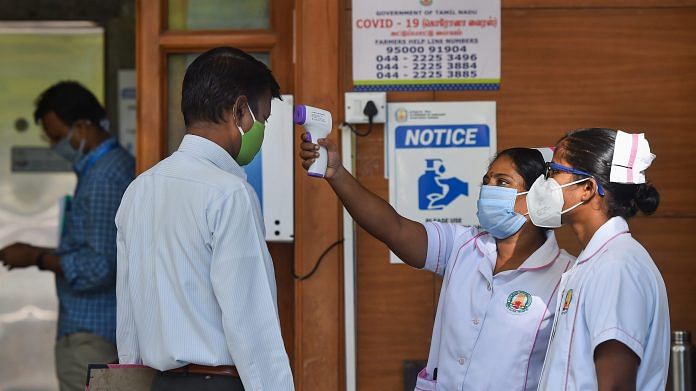New Delhi: India’s effective reproduction number ‘R’ for Covid-19 — a key parameter to measure the rate of spread of an infection — has increased to 1.09 this week from 1.04, which was the lowest India had recorded since the Covid pandemic began.
According to Sitabhra Sinha, a researcher at the Institute of Mathematical Sciences in Chennai, some of the worst-affected states are once again showing an upward trend in R values.
“If R remains unchanged, we are most likely to see India breach a million active cases by the middle of this month — just after 15 September or so,” Sinha told ThePrint.
R value as well as R0 (basic reproduction number) are an estimate of the number of people a patient can infect.
While R0 is calculated at the beginning of an epidemic, when the entire population is assumed to be susceptible to a disease, R changes with time and takes into account the fact that some individuals are protected from the illness — either because they have developed immunity or due to social distancing measures.
For India, the R0 was calculated to be about 1.83 in April. An epidemic is considered to be under control when the R value remains below 1 consistently.
As of Thursday, India has recorded 8,15,538 active cases of Covid-19. As many as 67,376 people have died from the infection so far and 29,70,492 people have recovered.
Also read: Jharkhand records highest Covid transmission rate, Andhra Pradesh positivity rises to 17.26%
R value in major cities
Delhi has seen a consistent rise in its daily case numbers and therefore its R value has also increased in the past two weeks to 1.18. While the national capital’s R value had dipped below 1 for a couple of weeks till 4 August, it increased to 1.09 around 18 August, up from 0.66 in the beginning of August.
Similarly, Mumbai’s R value increased to 1.1 this week from 0.86 around 18 August.
The values for Kolkata and Chennai on the other hand remained below 1, decreasing from 0.92 and 1.11 to 0.87 and 0.94, respectively.
Bengaluru’s R value is about 1.05 this week, a marginal decrease from 1.06 last week
Telangana records highest R value among worst-affected states
Maharashtra, Andhra Pradesh, Karnataka and Assam have reported sharp increases in the R values this week.
Maharashtra’s R value increased to 1.12 from 1.08 last month. The state had witnessed a consistent decrease in R value in the last several months but now the value is increasing.
Andhra Pradesh’s estimation had also been below 1 (0.90) around 18 August, but the value has now increased to 1.09 this week.
At 1.26, Telangana recorded the highest R value among the 12 worst-affected states in India this week. The state has seen a steady increase in its R value in the past week.
On 22 July, the value was estimated to be 0.90 for the southern state. It had increased to 1.18 a week later, and reduced steadily for a few weeks after that. However, it increased again in the past week, rising to 1.08 from 1.06 the week before.
Assam, too, has reported a sharp increase in the last week, with its R value increasing to 1.22 from 0.80 last week.
Tamil Nadu has kept its R value below 1 for the past two weeks, although there has been a slight increase this week. The value is about 0.99 from last week’s 0.97.
Similarly, the R value for Bihar increased to 0.86 this week from 0.77 last week.
Meanwhile, Orissa saw a decrease in its R value to 1.13 from 1.23.
“An R close to but greater than 1 means that the number of new daily cases is roughly the same or only very gently increasing. That is, of course, good news, because it says that the epidemic is somewhat contained and is not growing as explosively as it could have, in the absence of restrictions,” Gautam Menon, an expert in disease modelling and professor of Physics and Biology at Ashoka University, told ThePrint.
“To be really successful in containing it, one needs to push the R below 1 and have it stay consistently there for a while. This is the downward slope of the epidemic curve, which we have not seen happening yet,” Menon said.
Also read: India’s Covid fatality rate among lowest in world at 1.76%, says health ministry



